Xiaolong Xu
Reward-Driven Interaction: Enhancing Proactive Dialogue Agents through User Satisfaction Prediction
May 24, 2025Abstract:Reward-driven proactive dialogue agents require precise estimation of user satisfaction as an intrinsic reward signal to determine optimal interaction strategies. Specifically, this framework triggers clarification questions when detecting potential user dissatisfaction during interactions in the industrial dialogue system. Traditional works typically rely on training a neural network model based on weak labels which are generated by a simple model trained on user actions after current turn. However, existing methods suffer from two critical limitations in real-world scenarios: (1) Noisy Reward Supervision, dependence on weak labels derived from post-hoc user actions introduces bias, particularly failing to capture satisfaction signals in ASR-error-induced utterances; (2) Long-Tail Feedback Sparsity, the power-law distribution of user queries causes reward prediction accuracy to drop in low-frequency domains. The noise in the weak labels and a power-law distribution of user utterances results in that the model is hard to learn good representation of user utterances and sessions. To address these limitations, we propose two auxiliary tasks to improve the representation learning of user utterances and sessions that enhance user satisfaction prediction. The first one is a contrastive self-supervised learning task, which helps the model learn the representation of rare user utterances and identify ASR errors. The second one is a domain-intent classification task, which aids the model in learning the representation of user sessions from long-tailed domains and improving the model's performance on such domains. The proposed method is evaluated on DuerOS, demonstrating significant improvements in the accuracy of error recognition on rare user utterances and long-tailed domains.
LeetCodeDataset: A Temporal Dataset for Robust Evaluation and Efficient Training of Code LLMs
Apr 20, 2025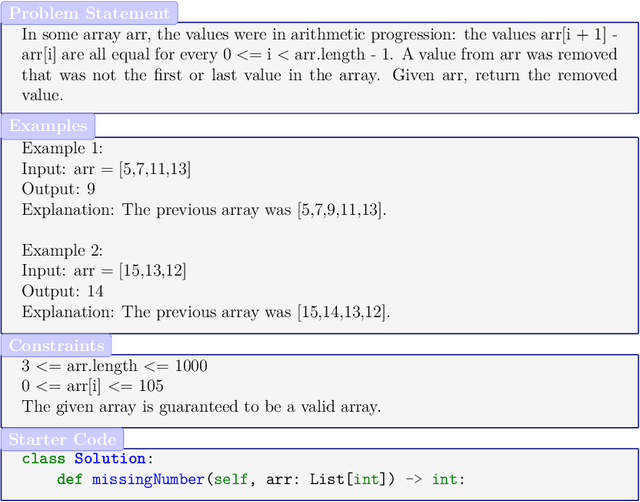

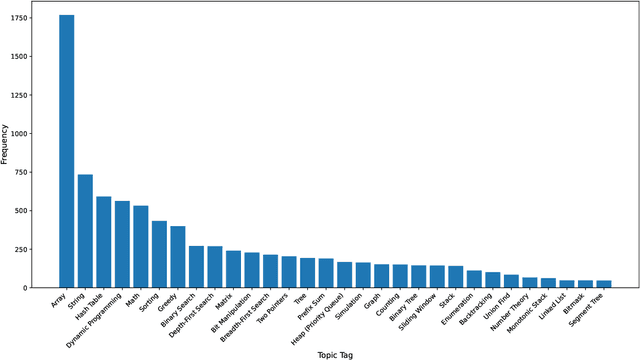

Abstract:We introduce LeetCodeDataset, a high-quality benchmark for evaluating and training code-generation models, addressing two key challenges in LLM research: the lack of reasoning-focused coding benchmarks and self-contained training testbeds. By curating LeetCode Python problems with rich metadata, broad coverage, 100+ test cases per problem, and temporal splits (pre/post July 2024), our dataset enables contamination-free evaluation and efficient supervised fine-tuning (SFT). Experiments show reasoning models significantly outperform non-reasoning counterparts, while SFT with only 2.6K model-generated solutions achieves performance comparable to 110K-sample counterparts. The dataset and evaluation framework are available on Hugging Face and Github.
CMCRD: Cross-Modal Contrastive Representation Distillation for Emotion Recognition
Apr 12, 2025



Abstract:Emotion recognition is an important component of affective computing, and also human-machine interaction. Unimodal emotion recognition is convenient, but the accuracy may not be high enough; on the contrary, multi-modal emotion recognition may be more accurate, but it also increases the complexity and cost of the data collection system. This paper considers cross-modal emotion recognition, i.e., using both electroencephalography (EEG) and eye movement in training, but only EEG or eye movement in test. We propose cross-modal contrastive representation distillation (CMCRD), which uses a pre-trained eye movement classification model to assist the training of an EEG classification model, improving feature extraction from EEG signals, or vice versa. During test, only EEG signals (or eye movement signals) are acquired, eliminating the need for multi-modal data. CMCRD not only improves the emotion recognition accuracy, but also makes the system more simplified and practical. Experiments using three different neural network architectures on three multi-modal emotion recognition datasets demonstrated the effectiveness of CMCRD. Compared with the EEG-only model, it improved the average classification accuracy by about 6.2%.
DapperFL: Domain Adaptive Federated Learning with Model Fusion Pruning for Edge Devices
Dec 08, 2024Abstract:Federated learning (FL) has emerged as a prominent machine learning paradigm in edge computing environments, enabling edge devices to collaboratively optimize a global model without sharing their private data. However, existing FL frameworks suffer from efficacy deterioration due to the system heterogeneity inherent in edge computing, especially in the presence of domain shifts across local data. In this paper, we propose a heterogeneous FL framework DapperFL, to enhance model performance across multiple domains. In DapperFL, we introduce a dedicated Model Fusion Pruning (MFP) module to produce personalized compact local models for clients to address the system heterogeneity challenges. The MFP module prunes local models with fused knowledge obtained from both local and remaining domains, ensuring robustness to domain shifts. Additionally, we design a Domain Adaptive Regularization (DAR) module to further improve the overall performance of DapperFL. The DAR module employs regularization generated by the pruned model, aiming to learn robust representations across domains. Furthermore, we introduce a specific aggregation algorithm for aggregating heterogeneous local models with tailored architectures and weights. We implement DapperFL on a realworld FL platform with heterogeneous clients. Experimental results on benchmark datasets with multiple domains demonstrate that DapperFL outperforms several state-of-the-art FL frameworks by up to 2.28%, while significantly achieving model volume reductions ranging from 20% to 80%. Our code is available at: https://github.com/jyzgh/DapperFL.
REFOL: Resource-Efficient Federated Online Learning for Traffic Flow Forecasting
Nov 21, 2024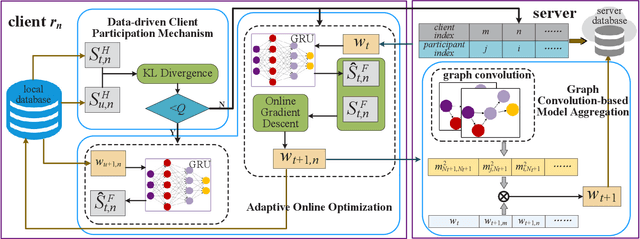
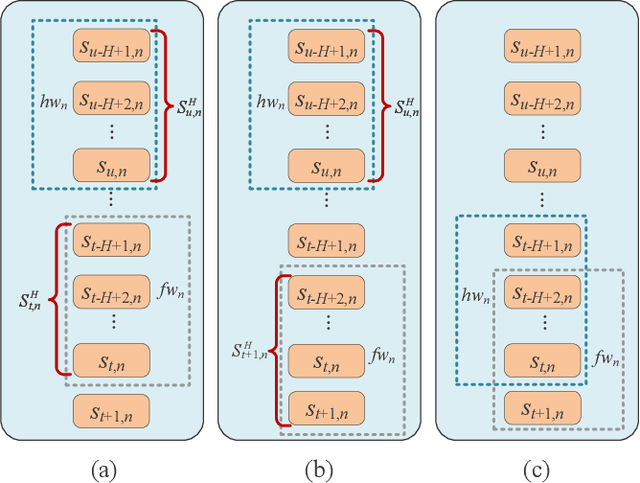


Abstract:Multiple federated learning (FL) methods are proposed for traffic flow forecasting (TFF) to avoid heavy-transmission and privacy-leaking concerns resulting from the disclosure of raw data in centralized methods. However, these FL methods adopt offline learning which may yield subpar performance, when concept drift occurs, i.e., distributions of historical and future data vary. Online learning can detect concept drift during model training, thus more applicable to TFF. Nevertheless, the existing federated online learning method for TFF fails to efficiently solve the concept drift problem and causes tremendous computing and communication overhead. Therefore, we propose a novel method named Resource-Efficient Federated Online Learning (REFOL) for TFF, which guarantees prediction performance in a communication-lightweight and computation-efficient way. Specifically, we design a data-driven client participation mechanism to detect the occurrence of concept drift and determine clients' participation necessity. Subsequently, we propose an adaptive online optimization strategy, which guarantees prediction performance and meanwhile avoids meaningless model updates. Then, a graph convolution-based model aggregation mechanism is designed, aiming to assess participants' contribution based on spatial correlation without importing extra communication and computing consumption on clients. Finally, we conduct extensive experiments on real-world datasets to demonstrate the superiority of REFOL in terms of prediction improvement and resource economization.
Real-time and Downtime-tolerant Fault Diagnosis for Railway Turnout Machines (RTMs) Empowered with Cloud-Edge Pipeline Parallelism
Nov 04, 2024



Abstract:Railway Turnout Machines (RTMs) are mission-critical components of the railway transportation infrastructure, responsible for directing trains onto desired tracks. For safety assurance applications, especially in early-warning scenarios, RTM faults are expected to be detected as early as possible on a continuous 7x24 basis. However, limited emphasis has been placed on distributed model inference frameworks that can meet the inference latency and reliability requirements of such mission critical fault diagnosis systems. In this paper, an edge-cloud collaborative early-warning system is proposed to enable real-time and downtime-tolerant fault diagnosis of RTMs, providing a new paradigm for the deployment of models in safety-critical scenarios. Firstly, a modular fault diagnosis model is designed specifically for distributed deployment, which utilizes a hierarchical architecture consisting of the prior knowledge module, subordinate classifiers, and a fusion layer for enhanced accuracy and parallelism. Then, a cloud-edge collaborative framework leveraging pipeline parallelism, namely CEC-PA, is developed to minimize the overhead resulting from distributed task execution and context exchange by strategically partitioning and offloading model components across cloud and edge. Additionally, an election consensus mechanism is implemented within CEC-PA to ensure system robustness during coordinator node downtime. Comparative experiments and ablation studies are conducted to validate the effectiveness of the proposed distributed fault diagnosis approach. Our ensemble-based fault diagnosis model achieves a remarkable 97.4% accuracy on a real-world dataset collected by Nanjing Metro in Jiangsu Province, China. Meanwhile, CEC-PA demonstrates superior recovery proficiency during node disruptions and speed-up ranging from 1.98x to 7.93x in total inference time compared to its counterparts.
AcademicGPT: Empowering Academic Research
Nov 21, 2023



Abstract:Large Language Models (LLMs) have demonstrated exceptional capabilities across various natural language processing tasks. Yet, many of these advanced LLMs are tailored for broad, general-purpose applications. In this technical report, we introduce AcademicGPT, designed specifically to empower academic research. AcademicGPT is a continual training model derived from LLaMA2-70B. Our training corpus mainly consists of academic papers, thesis, content from some academic domain, high-quality Chinese data and others. While it may not be extensive in data scale, AcademicGPT marks our initial venture into a domain-specific GPT tailored for research area. We evaluate AcademicGPT on several established public benchmarks such as MMLU and CEval, as well as on some specialized academic benchmarks like PubMedQA, SCIEval, and our newly-created ComputerScienceQA, to demonstrate its ability from general knowledge ability, to Chinese ability, and to academic ability. Building upon AcademicGPT's foundation model, we also developed several applications catered to the academic area, including General Academic Question Answering, AI-assisted Paper Reading, Paper Review, and AI-assisted Title and Abstract Generation.
Privacy-preserving design of graph neural networks with applications to vertical federated learning
Oct 31, 2023



Abstract:The paradigm of vertical federated learning (VFL), where institutions collaboratively train machine learning models via combining each other's local feature or label information, has achieved great success in applications to financial risk management (FRM). The surging developments of graph representation learning (GRL) have opened up new opportunities for FRM applications under FL via efficiently utilizing the graph-structured data generated from underlying transaction networks. Meanwhile, transaction information is often considered highly sensitive. To prevent data leakage during training, it is critical to develop FL protocols with formal privacy guarantees. In this paper, we present an end-to-end GRL framework in the VFL setting called VESPER, which is built upon a general privatization scheme termed perturbed message passing (PMP) that allows the privatization of many popular graph neural architectures.Based on PMP, we discuss the strengths and weaknesses of specific design choices of concrete graph neural architectures and provide solutions and improvements for both dense and sparse graphs. Extensive empirical evaluations over both public datasets and an industry dataset demonstrate that VESPER is capable of training high-performance GNN models over both sparse and dense graphs under reasonable privacy budgets.
OptIForest: Optimal Isolation Forest for Anomaly Detection
Jun 23, 2023
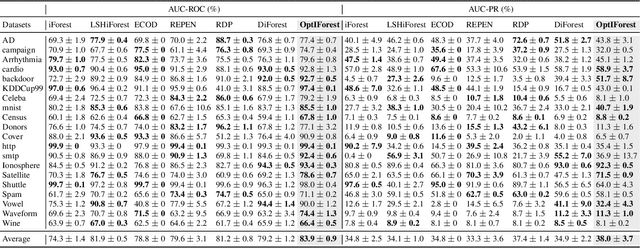
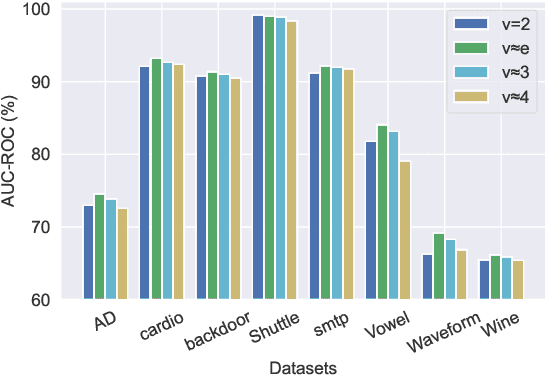
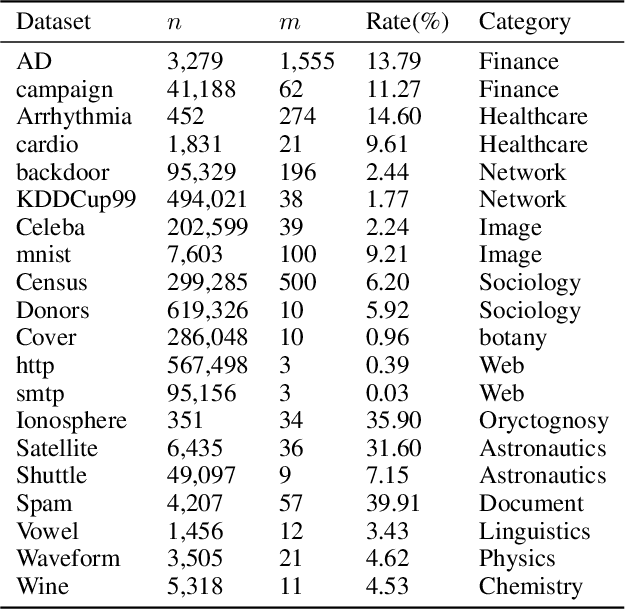
Abstract:Anomaly detection plays an increasingly important role in various fields for critical tasks such as intrusion detection in cybersecurity, financial risk detection, and human health monitoring. A variety of anomaly detection methods have been proposed, and a category based on the isolation forest mechanism stands out due to its simplicity, effectiveness, and efficiency, e.g., iForest is often employed as a state-of-the-art detector for real deployment. While the majority of isolation forests use the binary structure, a framework LSHiForest has demonstrated that the multi-fork isolation tree structure can lead to better detection performance. However, there is no theoretical work answering the fundamentally and practically important question on the optimal tree structure for an isolation forest with respect to the branching factor. In this paper, we establish a theory on isolation efficiency to answer the question and determine the optimal branching factor for an isolation tree. Based on the theoretical underpinning, we design a practical optimal isolation forest OptIForest incorporating clustering based learning to hash which enables more information to be learned from data for better isolation quality. The rationale of our approach relies on a better bias-variance trade-off achieved by bias reduction in OptIForest. Extensive experiments on a series of benchmarking datasets for comparative and ablation studies demonstrate that our approach can efficiently and robustly achieve better detection performance in general than the state-of-the-arts including the deep learning based methods.
SAD: Semi-Supervised Anomaly Detection on Dynamic Graphs
May 23, 2023



Abstract:Anomaly detection aims to distinguish abnormal instances that deviate significantly from the majority of benign ones. As instances that appear in the real world are naturally connected and can be represented with graphs, graph neural networks become increasingly popular in tackling the anomaly detection problem. Despite the promising results, research on anomaly detection has almost exclusively focused on static graphs while the mining of anomalous patterns from dynamic graphs is rarely studied but has significant application value. In addition, anomaly detection is typically tackled from semi-supervised perspectives due to the lack of sufficient labeled data. However, most proposed methods are limited to merely exploiting labeled data, leaving a large number of unlabeled samples unexplored. In this work, we present semi-supervised anomaly detection (SAD), an end-to-end framework for anomaly detection on dynamic graphs. By a combination of a time-equipped memory bank and a pseudo-label contrastive learning module, SAD is able to fully exploit the potential of large unlabeled samples and uncover underlying anomalies on evolving graph streams. Extensive experiments on four real-world datasets demonstrate that SAD efficiently discovers anomalies from dynamic graphs and outperforms existing advanced methods even when provided with only little labeled data.
 Add to Chrome
Add to Chrome Add to Firefox
Add to Firefox Add to Edge
Add to Edge